Survival Food
Mayukh Sen
October 8, 2019
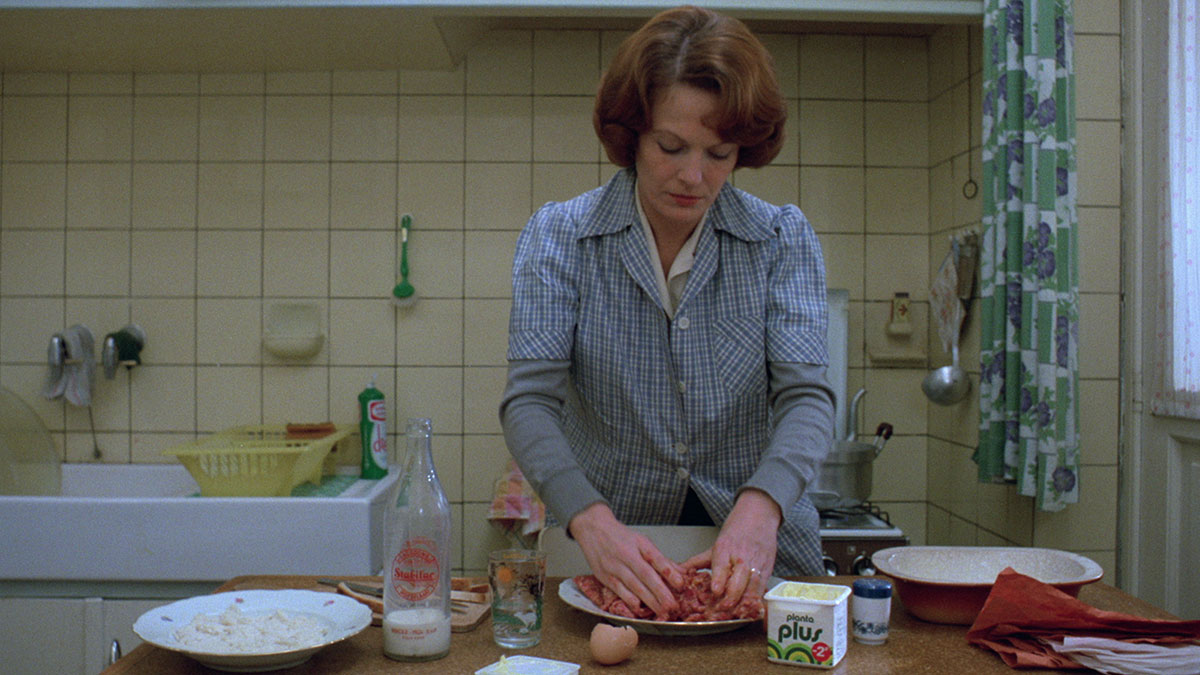
In August 2009, to mark its release of Chantal Akerman’s Jeanne Dielman, 23, quai du Commerce, 1080 Bruxelles (1975), the Criterion Collection challenged the public to a cooking contest. Criterion asked viewers to film themselves, or others, cooking meatloaf, veal cutlets, or potatoes, three of the meals that Dielman (Delphine Seyrig), a dour middle-aged widow in Brussels, prepares over the course of three days.
“There’s more to cooking on camera than Top Chef,” the teaser for the Criterion contest began, “and despite films like Big Night or Julie and Julia that have inspired foodies across the country to run out and prepare elaborate meals, it’s rare that we get a cinematic look at how ordinary folks cook every day.”
The words resonate a decade later. The images of cooking that Akerman made material in Jeanne Dielman feel far too uncommon on celluloid. The culture we inhabit doesn’t celebrate cinematic depictions of cooking like Jeanne Dielman’s as readily as it fetes films that turn food into objects of lust. Instead, Julie & Julia, by retracing Julia Child’s culinary legacy through the soft-focus gaze of a young blogger named Julie Powell, positions cooking as a portal to self-fulfillment, thus enduring as food cinema.
So too does Juzo Itami’s Tampopo (1985), the mascot of the food film genre, a madcap, balletic film that follows two male drifters aiding a widowed ramen shop owner in her quest to perfect her recipe for a bowl of ramen. Take the aforementioned Big Night (1996), by Campbell Scott and Stanley Tucci. The film charts the struggles of two immigrant Italian brothers, living in a town along the Jersey Shore during the 1950s, and their desire to cook what they see as legitimate Italian food in a sea of soulless simulacrums that cater to incurious American tastebuds.
But what to make of Jeanne Dielman, and its desultory scenes that capture the rhythm of domestic routine in slow motion? In a sequence that yawns over four minutes, Akerman observes Dielman, in her pallid baby-blue apron, fold and press a mound of meatloaf that’s as pliable as Play-Doh. She catalogs Dielman peeling potatoes, moving with bored assurance. She watches Dielman pat veal against a table chalked with flour, eggs, and breadcrumbs, slapping it against the table’s surface over and over again until the breading clings to the meat. Akerman turns the kitchen into a chamber of stupefying ritual, though the fabric of Dielman’s routine begins to rupture on a day when she burns potatoes.
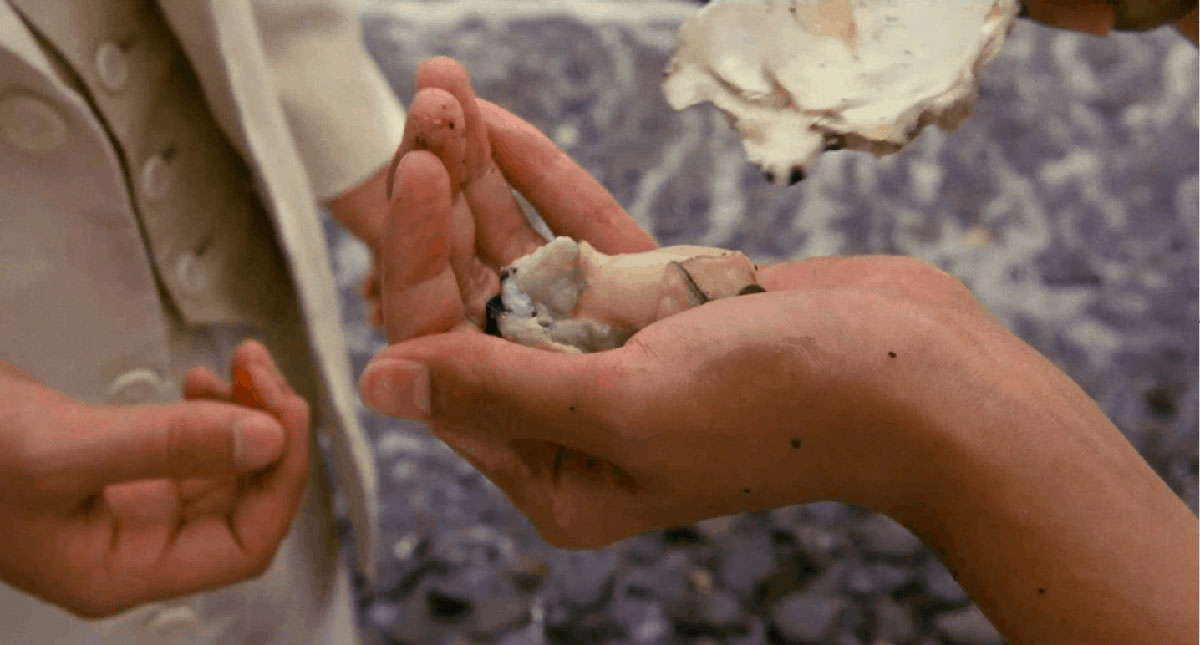
In re-examining these scenes of Dielman cooking, I found myself scribbling down words to describe the imagined flavors and textures of the meals she cooked and erasing them. The exercise felt strained and futile, a betrayal of the text at hand. I’ll admit that I ran into a pretty rudimentary roadblock here: I could barely see the food. Akerman frames her subject from a distance. There’s no romance to Akerman’s treatment of Dielman as a home cook. In Jeanne Dielman, food is not a vehicle for pleasure. Food is a means for survival, a daily task carrying her over from one day to the next. It’s not a hobby.
If the unspoken professional imperative for a food writer is to make the reader hungry, Jeanne Dielman tests the limits of such a directive. The film is a cinematic appetite suppressant. It’s impossible to describe the film’s meals with the purple, appetite-urging language that food writers are professionally obligated to employ. Still, in spite of the challenges it puts forth towards classification, I’d argue Jeanne Dielman is very much a food film. Akerman’s acute observations of her subject cooking sustain the film’s anxious heartbeat, leading us through a lullaby that ends in a nightmare.
Akerman’s allergy to eroticizing food may explain why Jeanne Dielman, in spite of its fixation on the act of cooking, has resisted entry into the canon of food cinema that has ossified around a fixed set of films. The genre began coming into focus in the mid-1980s with Tampopo, followed by Babette’s Feast (1987), drawn from a story by Danish writer Isak Dinesen. Babette’s Feast concerns a refugee from the Paris Commune who, in the late 19th century, wanders into the home of two sisters living in a Danish village and works as their cook. As the title teases, the film culminates in a feast that showcases Babette’s culinary sorcery, with bowls of turtle soup and buckwheat blinis pecked with sour cream and caviar.
The genre slouches into the following decade with Eat Drink Man Woman (1994), an Ang Lee film that concentrates on an aging chef’s attempts to connect to his three adult daughters through elaborate Sunday dinners they seldom appreciate, and Big Night (1996). On occasion, the genre has accommodated such films as Like Water for Chocolate (1992), where the youngest daughter of a Mexican family turns cooking into an outlet for her animal urges, her repression finding relief through quails soaked in rose petal sauce.1 2 3
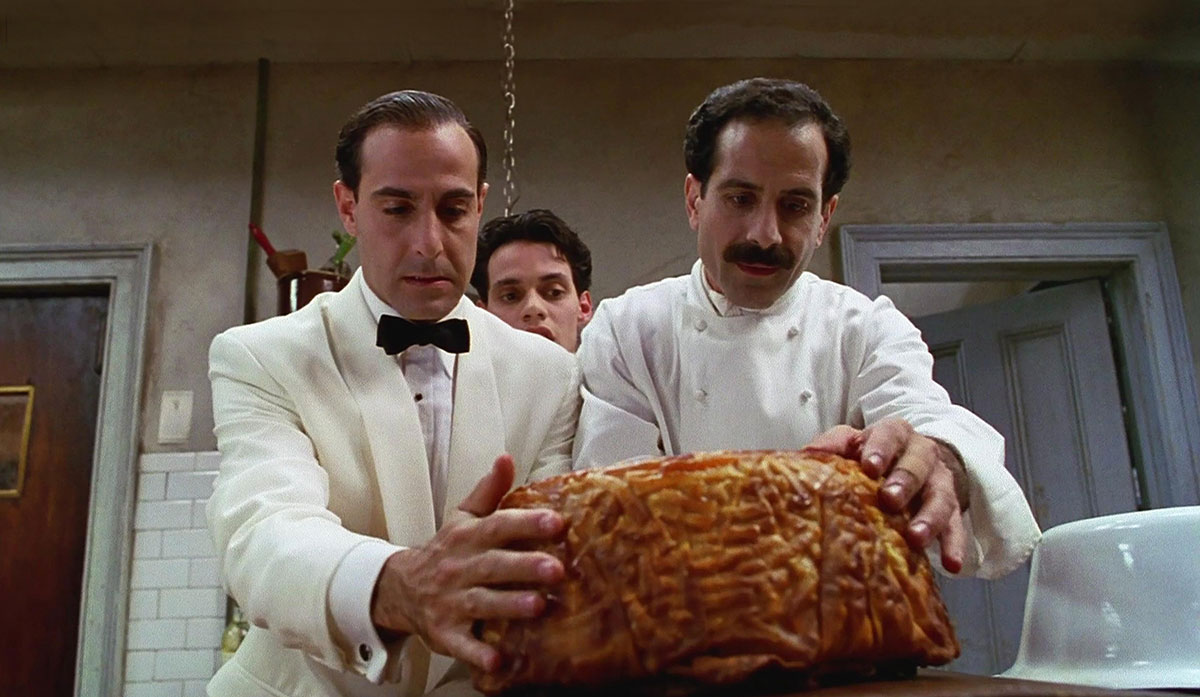
The chief element uniting these films is their visual excess. They are wired to induce hunger, turning food into a main character, an organism who demands the forensic intimacy of the close-up. When the camera lingers on an oyster plucked from water that slips into a pearl diver’s palm in Tampopo, I can smell the salt of the seawater from which it emerged, anticipating the rush of that small monster’s sludge against my tongue. When a knife squeezes through the skin of timpano, a showstopper of a dish that represents the apex of the brothers’ culinary expression in Big Night, the cut reveals a tangle of pasta, egg, salami, and meatballs. The gesture alarms me in its luridness, as if intruding on the most private corners of my appetite. To put it in plain terms, these films make me hungry. If you were to look at these films as a collective, you may believe that the primary function of a food film is to arouse hunger.
Yet, the canon of food cinema feels rigid and inflexible, as if in dire need of a rewrite. Our greatest food films may be in hiding.
Countless films feature prominent food scenes, and they aren’t quite the ones I’m talking about when I suggest that the canon of food cinema needs expanding. Some sequences in film, like Jack Nicholson insisting on a modified chicken salad sandwich—hold the chicken—in Bob Rafelson’s Five Easy Pieces (1970), have burrowed their way into popular memory with great force.
I have my own cherished scenes. It’s hard to walk away from Alan J. Pakula’s Klute (1971) without remembering Jane Fonda slipping fruit into her satchel while shopping for produce with Donald Sutherland. I can’t escape Elaine May’s The Heartbreak Kid (1972) without the image of Jeannie Berlin’s clueless face dripping with egg salad sandwich guts.
The food film is different. I’m talking about a film that makes food its central character, a character who animates the plot rather than existing in the peripheries. There have been quiet appeals to stretch the canon along these very lines. In a 2012 essay for the now-defunct food magazine Lucky Peach, the late Anthony Bourdain squeezed Marco Ferreri’s La Grande Bouffe (1973) into the conversation, putting it forth as a rejoinder to the genre of food film as the world had come to know it. The film hinges on four bachelors whose hedonism veers into such chaos that they eat themselves to death. The film’s outcome prompted Bourdain to hail it as a “withering, merciless satire, whose loathing for the human body and its appetites makes Pasolini’s Salò, or The 120 Days of Sodom look like a Disney film.”
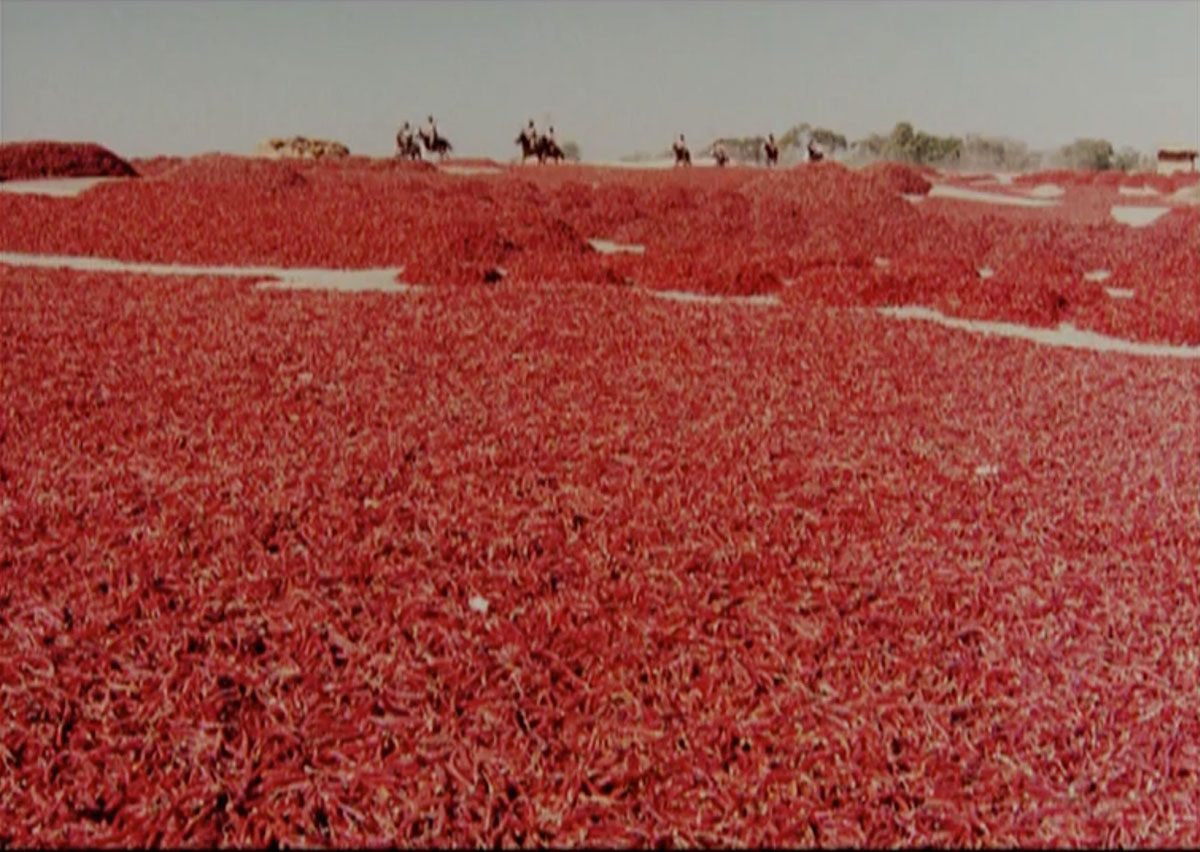
Three years ago, when food celebrity Alton Brown curated a food and film series for Metrograph, he found room for Peter Greenaway’s The Cook, the Thief, His Wife & Her Lover (1989) alongside the usual suspects (Tampopo, Babette’s Feast, Eat Drink Man Woman, and Big Night). Greenaway fills his film with tracking shots of a restaurant kitchen in a gangster-populated underworld; the film builds towards a cannibalistic climax.
Upon the release of Paul Thomas Anderson’s Phantom Thread (2017), a film that slyly complicates the trope of the woman who cooks to express love, the New Yorker’s Helen Rosner praised the film for illuminating “the kitchen’s ever-present sinister side.” Phantom Thread’s characters weaponize food: The sound of the scratch of a knife against toast aggravates Reynolds Woodcock (Daniel Day-Lewis) so violently that he tries to police the behavior of his lover, Alma (Vicky Krieps). She flips the dynamic on its head, cooking him meals dripping with poison.
Even these films lean on similar visual cues, their frames packed with the ornate closeups of dishes that have become hallmarks of the food film, be they the suckling pigs jammed with chestnuts in La Grande Bouffe or Alma’s butter-soaked mushroom omelet in Phantom Thread. The films are engineered to entrance, to stir the stomach, to eventually push us away from reality’s hard edges. It’s no coincidence that treating food as an object of luxury has long been the prevailing mission of food writing itself.
Sixteen years have passed since the late food writer Molly O’Neill lamented, in the pages of the Columbia Journalism Review, that “[f]ood porn — prose and recipes so removed from real life that they cannot be used except as vicarious experience — has reigned.” “Pornography” is a dangerous word, as if inviting you to casually misapply it. Yet O’Neill’s usage here is germane to our understanding of food writing as it developed over the last century. O’Neill understood that food holds great narrative capacity to probe broader cultural truths. The mission to transport the consumer to aspirational heights has long been the guiding credo of professional food writers, often at the expense of acknowledging the realities of food’s potential to sow division.
The fundamental disconnect between the food writer and the reader may be food writing’s main point of appeal. Food writing can provide a glossy getaway from reality, yet the crusade for delight that O’Neill wrote of has continued to keep a troubling majority of food writing a cramped, inaccessible space. The discipline of food writing contains a tradition of stories that poke at power (most of them tucked in such magazines as Gourmet and Lucky Peach and Modern Farmer). Yet such stories can still feel like outliers in a landscape infatuated with giving readers respite from the world’s drumbeat of horrors.
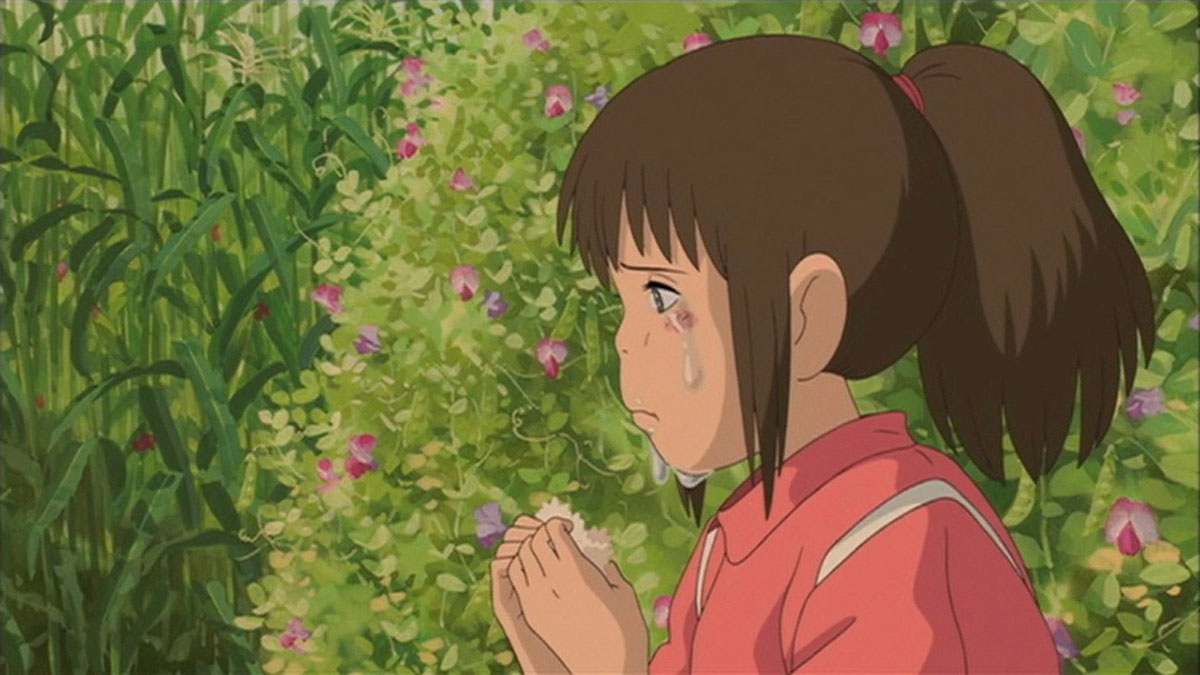
What might O’Neill have made of Satyajit Ray’s Ashani Sanket (1973)? Ray structures the film around the absence of food, not its omnipresence, tracking the slow degradation of a village living through the Bengal famine of 1943. Food’s ghost hovers over every frame of this film, focusing on the granular story of a Bengali couple to capture the enormity of the famine’s destruction.
Indian director Ketan Mehta threads a single ingredient, the red chili, into the texture of Mirch Masala (1987). The film focuses on Sonbai (Smita Patil), a woman in a colonial Indian village who seeks shelter in a chili factory to dodge the advances of a lecherous subedar, or tax collector (Naseeruddin Shah). Mehta soaks the film’s frames with the pulse of red chilies; in the film’s final scene, a band of women who work at the factory throw ground red chili powder in the subedar’s eyes, blinding him in an expression of solidarity with Sonbai. The red chili has the potency to incapacitate and destroy, allowing the women to reconfigure the sexual dynamics that have suffocated them.
Neither film has made much of a dent in discussions about food in cinema, partly, I suspect, for their purposeful rejection of the sumptuous aesthetic that marks such films as Tampopo or Babette’s Feast. The slant towards visual floridity reflects, too, the more recent cultural fascination with food in Studio Ghibli movies. Dazzling meals permeate the Ghibli universe. Consider the herring and pumpkin pot pie with blistered edges that the titular character of Kiki’s Delivery Service (1989) brings to a grousy teenage customer. Food creeps into every emotional corner of Hayao Miyazaki’s Spirited Away (2001). The dream bathhouse Chihiro lives in overflows with glorious feasts, while a simple rice cake becomes a cushion for her tears when she misses home.
Yet the Ghibli film that makes me contemplate the human relationship to food more than any other is Isao Takahata’s Grave of the Fireflies (1988). Takahata works with scary precision to illustrate his characters’ bottomless hunger, a condition of living in wartime Japan. Food’s pleasures are imaginary in Grave of the Fireflies, too, though perhaps not quite in the same fantastical way that Like Water for Chocolate or Big Night’s are. The film’s most piercing image is that of a small tin of Sakuma fruit drops that young Setsuko clings to as she begins to suffer from malnutrition following the firebombing of Kobe during World War II. Her older brother, Seita, drops the candies into her mouth one night as they stand in a field sweating with fireflies, the candies like galactic shards of sugar. Food grows more scarce as the film plods on. Starvation makes Setsuko’s appetite swell, giving way to a series of hallucinations. As the young child crawls towards death, she fills her candy tin with marbles and confuses rocks for rice balls. The image of his small sister filling her tiny belly with rocks alarms Seita. Seita feeds her a slice of watermelon, which dissolves into her mouth. As he promises to make her rice gruel with eggs, she dies.
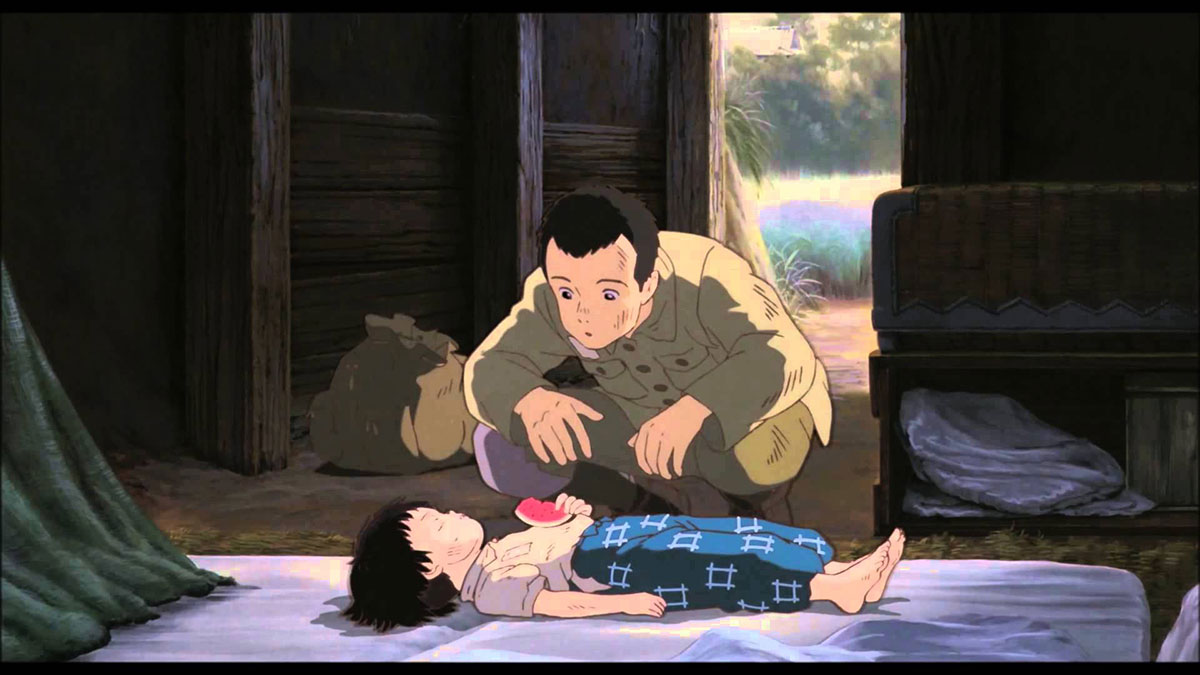
Hunger is a devilishly difficult state to visualize. The great power of this film is Takahata’s ability to depict how violently the strife of war shrivels Setsuko’s appetite. Still, Grave of the Fireflies has dodged most discussions about food in Ghibli’s films precisely because its treatment of food is so bleak. The film takes place in wartime Kobe, not the seaside town where the young witch Kiki flies to on her broom or the thrillingly grotesque wonderland where Chihiro resides. Grave of the Fireflies acknowledges a reality the viewer would rather not inhabit, where food is no guarantee. Takahata realizes the full potential of the food film, understanding that what we eat is an uncommonly useful lens through which to process the world’s inequities or, on a more granular level, the spectrum of human behavior. The film has no desire to soothe.
As food disappears from the narrative, the characters yearn for it, but their appetite finds no release. The truth provokes discomfort. When the candy tin empties, Takahata reminds us that we do not always eat in pursuit of joy. Sometimes, we eat in search of survival.
That there’s so little room for a movie like Grave of the Fireflies in broader considerations about food in cinema is a tell. The cultural renderings of food that resonate with audiences have too often tethered themselves to gratification, as if to distract from life’s sorrows and pains. The food film may best be understood in more robust, generous terms, then, as a genre that can accomplish more than filling the human appetite. Our most perceptive food films remind us that those appetites have boundaries.
- Feasting Our Eyes: Food Films and Cultural Identity in the United States, 2.
- Food in the Movies, 2d ed., 19.
- https://gefs.ucpress.edu/content/9/2/25